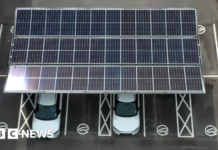Natural gas is often viewed as the clean fossil fuel because its burning emits much less emissions than coal and oil—50 to 60 percent less CO2 than coal. It is said to be the bridge to a clean energy future when renewable energy will become the dominant energy platform. But that’s not the real story. It’s only half the story. Natural gas truly is the classical bridge to nowhere. (Editor’s intro)
(This article is sourced from a Climate Reality factsheet about natural gas.)
Credit: Infographic by Union of Concerned Scientists
The Basics
Natural gas is a growing energy source—one many are putting a lot of faith in. But
the arguments in support of natural gas are often based on outdated or incorrect
information (sometimes going so far as to border on wishful thinking).
Proponents like to portray the fuel as a cuddlier cousin to coal and oil when it
comes to climate because it generates less carbon dioxide when burned. But its CO2
emissions are only one piece of a far more nuanced puzzle.
What is Natural Gas?
Like coal and oil, natural gas is a fossil fuel. Fossil fuels (which we burn to generate
heat and electricity) are non-renewable sources of energy formed in the earth over
the past 550 million years, typically from the remains of marine microorganisms
and plants. Sealed off from oxygen and put under ever-increasing amounts of heat
and pressure, this organic matter undergoes a thermal breakdown process that
ultimately converts it to hydrocarbons.
The lightest of these hydrocarbons occur in a gaseous state known collectively
as “natural gas,” which in its pure form is a colorless, odorless gas composed
primarily of methane.
QUICK FACTS
- Natural gas is frequently produced through hydraulic fracturing – better known
as “fracking.” Studies have found that fracking is one of the least sustainable
ways to produce electricity. - Natural gas is not a zero-emissions fuel. When burned, it produces
approximately half the carbon emissions of coal per unit of electricity generated.
But the drilling, extraction, and pipeline transportation of natural gas frequently
results in methane leakage. These leaks can sometimes be substantial. - Methane is especially bad for our climate – because it’s very effective at
absorbing heat. In the first 20 years after its release, it’s 86 times stronger than
CO2 at trapping heat in the atmosphere. - Ethylene, one of the major building blocks used in making plastics, is derived
from natural gas at ethane cracker plants. People living and working at or near
petrochemical facilities like these can have higher rates of cancer, respiratory
problems, and other life-altering diseases. - The International Energy Agency (IEA) reports that in 2017 global natural gas
production hit a record high, representing a 3.6 percent increase over 2016 and
the largest year-over-year increase since 2010. - By 2050, natural gas may provide as much as 56 percent of the US electricity
mix, nearly double what it is today. - A natural gas-dominated electricity system would continue to heat up
the planet.
Is It Really Cheaper Energy?
According to the Union of Concerned Scientists (UCS), “Domestic supplies of
natural gas have increased dramatically in recent years, due in large part to the
development and expansion of hydraulic fracturing (fracking) drilling techniques.
This increased supply – which is expected to continue for years – has lowered
prices for natural gas, making it very cost-competitive compared to other energy
sources.”
But that is only part of the story. Market prices for fossil fuels are kept artificially
low, in part, by government subsidies. And these prices also do not take into
account the cost of the climate change created by burning them. And climate
change carries tremendous costs for all of us. Period.
A BRIDGE TO NOWHERE
Fossil fuels (all of them!) are the energy of the past. With newer technologies
like wind, solar, and advanced batteries in our hands, we can power today and
tomorrow with clean, reliable energy that doesn’t harm our health and destroy our
planet.
It’s clear: We must transition away from dangerous, dirty fossil fuels (all of them!)
and invest in clean, reliable energy. Renewable energy is good for our health, our
climate, and our economies.
In Canada: A 2017 report by Environmental Defence shows that methane emissions in Alberta are 60% higher than the oil and gas industry reports. “The oil and gas industry is underreporting methane emissions and at the same time lobbying federal and provincial governments to weaken methane regulations,” according to Dale Marshall, National Program Manager, Environmental Defence. “Reducing methane emissions is the one measure in the pan-Canadian climate framework that is focused on the oil and gas sector. Yet, the industry is attempting to avoid responsibility and not do its fair share to tackle climate change.” (Editor’s notes)
Rising Methane Levels A Bigger Threat Than CO2
Alberta’s Tar Sands Expansion Is Killing Canada’s National Climate Goals
This work is licensed under a Creative Commons Attribution-NonCommercial 4.0 International License.













So what energy source should power a furnace or boiler installed today?
James – welcome to Below2C.
The power source for a heating system should be electric. That said, it depends on where you live. If your electricity is provided from a coal plant, than natural gas would be a better source for now.
Thanks for your comments/feedback.